Traveling with a toddler is an adventure, but figuring out transportation, especially car seats, can feel like solving a complex puzzle. How do you explore a new city without the everyday convenience of your car and car seat? Is lugging a travel car seat really practical, or are there safer, more convenient alternatives? These are the questions every parent grapples with when planning a trip with their little one.
For years, transportation logistics have been the trickiest part of my family travel planning. Finding the right balance between safety, practicality, and ease when transporting a baby and toddler without our usual car seat setup has been a continuous learning curve. There’s no single, perfect solution, and every family has a different comfort level when it comes to managing risk while traveling with young children.
This guide shares my experiences and insights on navigating transportation with a toddler without a car seat, offering practical tips and considerations to help you make informed decisions for your family travels.
Planning Your Toddler Travel Transportation in Advance
Before you even pack your bags, the key to stress-free toddler travel transportation is research and planning. Having a solid plan in place before you arrive at your destination prevents rushed decisions and ensures you choose options you are comfortable with.
Delve into travel blogs and forums to understand the local transportation landscape for families with young children. How do local families get around? What experiences have other travelers had with baby transportation? What is the local attitude and availability of car seats – are they common, or will taxis be unfamiliar with them? Are seat belts standard in taxis and ride-sharing vehicles?
If your vacation includes a resort stay, inquire about their transportation provisions for young children. They might offer car seat rentals, or perhaps your excursions will primarily utilize car seat-equipped charter buses.
The more information you gather beforehand, the better prepared you’ll be to minimize potential transportation risks and ensure your toddler’s safety.
 traveling baby standing in front of impressive bell tower
traveling baby standing in front of impressive bell tower
Prioritizing Public Transportation for Toddler-Friendly Travel
When it comes to safety and convenience, public transportation is often my top choice for getting around with a toddler. Trains and monorails are generally the safest options, followed by buses. When booking accommodations, I prioritize locations with easy access to these public transit systems.
For instance, during a trip to Thailand, research indicated that bringing a car seat wasn’t practical due to the limited seat belt availability. Therefore, in Bangkok, we chose a hotel within walking distance of a monorail station. This allowed us to travel directly from the airport and reach most of our desired destinations using the monorail, minimizing the need for taxis.
Amsterdam, with its excellent bus network, offers another example. We opted for an apartment conveniently located near a bus stop. Our only taxi ride was from the airport to the apartment, and fortunately, Amsterdam taxis are car seat-friendly, allowing us to safely use our travel car seat for that journey.
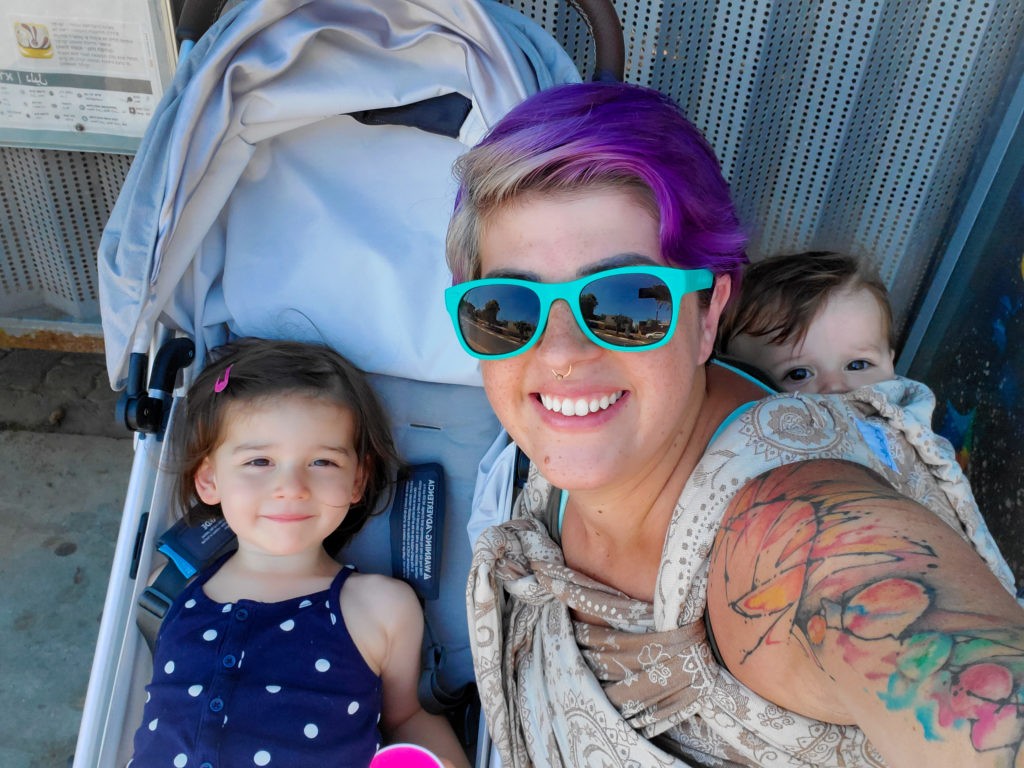 woman in sunglasses smiling with baby on back in carrier and toddler in uppababy minu stroller in a bus stop
woman in sunglasses smiling with baby on back in carrier and toddler in uppababy minu stroller in a bus stop
Bus Travel with Toddlers: A Safe Alternative
Yes, buses are considered a safe mode of transportation for toddlers. In fact, most buses are not designed for car seat installation. However, bus travel, even on highways, remains a relatively safe way to travel, offering a secure alternative to taxis or personal cars in many situations.
Renting a Car and Utilizing Your Travel Car Seat for Toddler Safety
If your destination and travel style align with car rentals, this can be a great option, particularly for families who value the familiarity and safety of their own car seat. Consider bringing your regular car seat or investing in a lightweight travel car seat. The Cosco Scenera NEXT Convertible Car Seat is a highly recommended, budget-friendly option popular as a secondary travel car seat. For frequent travelers seeking a higher-end, more durable travel car seat, the Wayb Pico is worth considering, though I haven’t personally tested it. Expert reviews, like this one on Travel Car Seat Mom, can offer valuable insights.
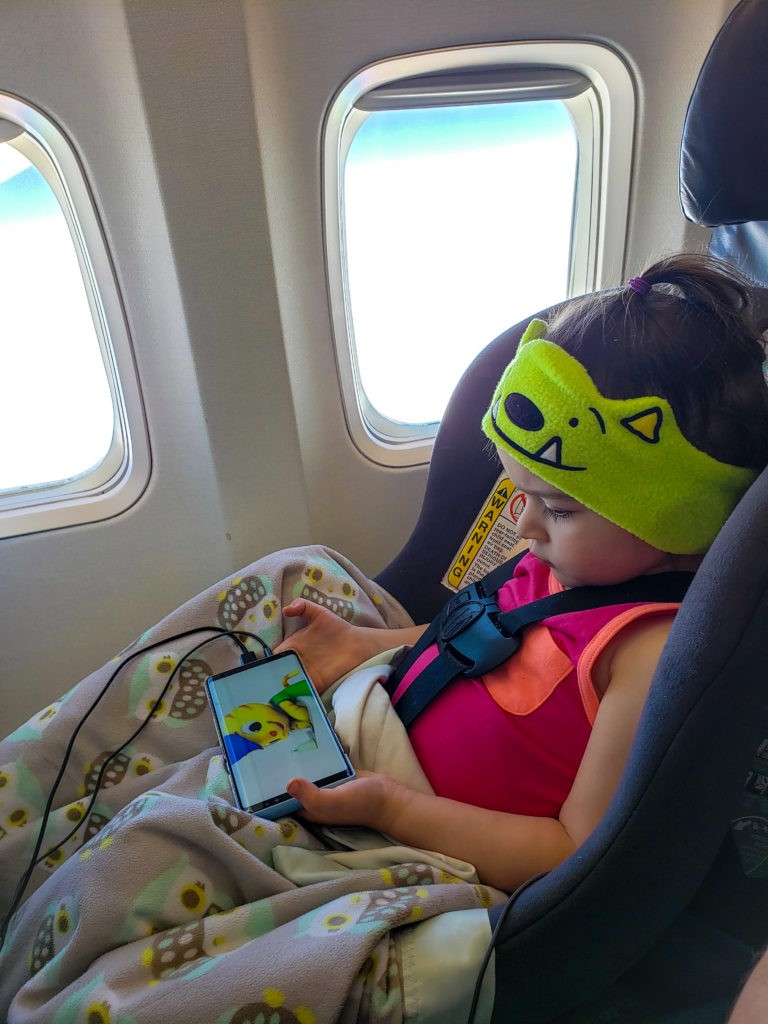 toddler in car seat on airplane watching a phone
toddler in car seat on airplane watching a phone
For children under three, bringing a car seat on the plane is highly recommended. It enhances safety during takeoff and landing, and provides a familiar and comfortable environment for your toddler during the flight itself.
Checking Car Seats for Air Travel: Cost-Free Convenience
Even if you prefer not to use the car seat on the plane, checking it at the gate is always free on US airlines and in most countries. Using a car seat bag or box is crucial to protect it from damage during transit.
While car rental companies typically offer car seats for rent, there are potential drawbacks. Selection may be limited, potentially resulting in the wrong size or even a less-than-clean car seat. More importantly, the safety history of rental car seats is often unknown – they could have been involved in accidents, compromising their integrity. While I once rented a car seat in Mexico that seemed fine, the uncertainty remains. Considering that rental costs can often exceed the price of an affordable travel car seat like the Cosco Scenera NEXT, bringing your own is often the more reliable and cost-effective choice.
Some travelers consider purchasing a car seat at their destination and donating it before returning home. While an option, it may not be more convenient than simply traveling with your own car seat.
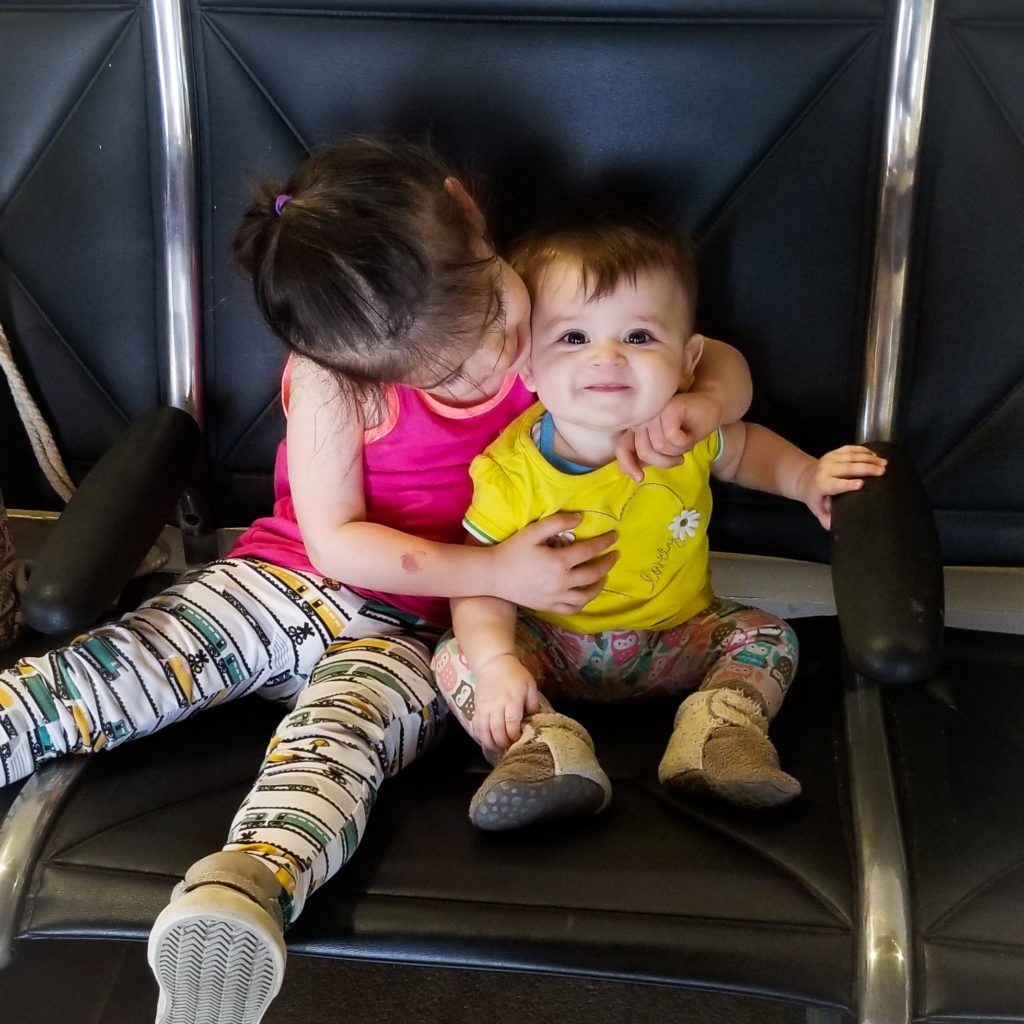 toddler holding baby in airport chairs
toddler holding baby in airport chairs
Private Drivers and Car Seats: A Comfortable Toddler Travel Option
If renting a car isn’t feasible or if you plan to move frequently during your trip, hiring a private driver can be a worthwhile alternative. In some locations, this can be surprisingly affordable, especially when you consolidate multiple shorter trips into days with a driver. This approach allows you to see more sights without the stress of navigating numerous taxi rides. We utilized this strategy in Indonesia, exploring various temples and sites across Bali at a reasonable price and with added convenience.
As with car rentals, bringing your own car seat from home is recommended when using private drivers. Confirm with the driver company in advance to ensure they are comfortable with car seat installation. While some companies offer car seats for loan, the quality and safety history may be uncertain.
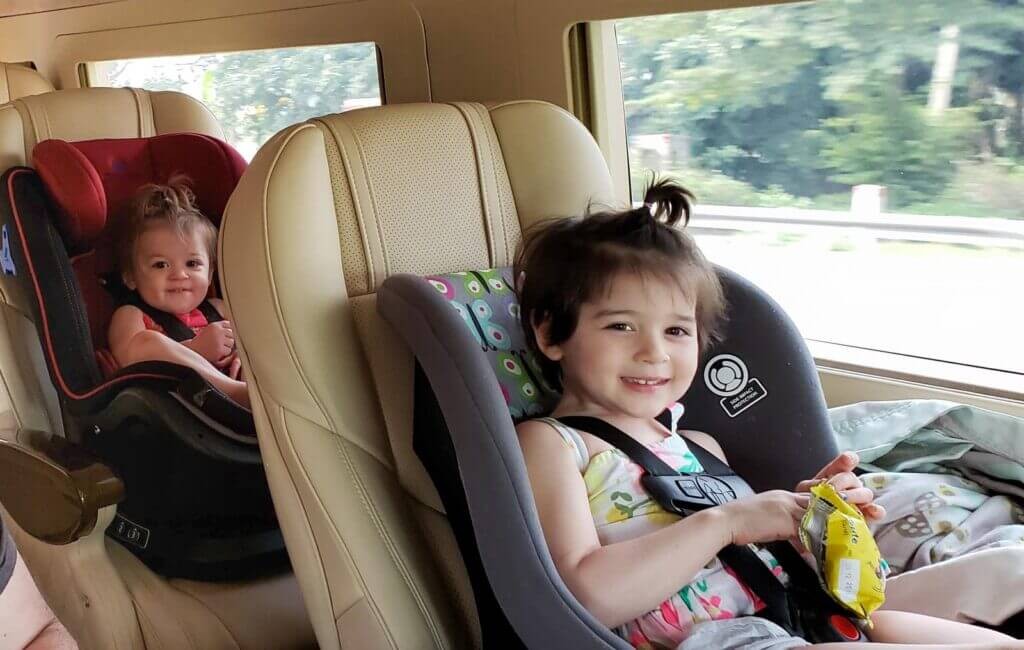 child and baby each in a car seat in large van
child and baby each in a car seat in large van
Private airport transfers are also a preferred option for many families. Knowing a driver is waiting for you upon arrival, potentially with a pre-arranged car seat, offers peace of mind. This is our usual choice for airport-to-hotel transportation with a baby or toddler.
Renting Car Seats Locally for Toddler Travel Convenience
A growing trend in travel is the emergence of baby gear rental companies at travel destinations. BabyQuip is a popular service, primarily in North America but expanding globally, connecting travelers with local families who rent out baby equipment. Similar services exist worldwide.
Renting from companies like BabyQuip allows you to rent from local families, often with access to reviews and assurances of high-quality, safe products. This is a convenient way to secure a car seat appropriate for your toddler’s age and weight, with detailed product information available online. You can arrange for car seat delivery to your hotel or, in some cases, even directly to the airport.
One logistical point to consider with local car seat rentals is airport transportation upon arrival and departure. You’ll still need to get to and from your home airport, which may require a car seat. Having a friend or family member drive you in your car, or one with your car seat installed, is ideal. Alternatively, airport parking, while potentially pricier than a taxi, can simplify logistics when traveling without a car seat of your own.
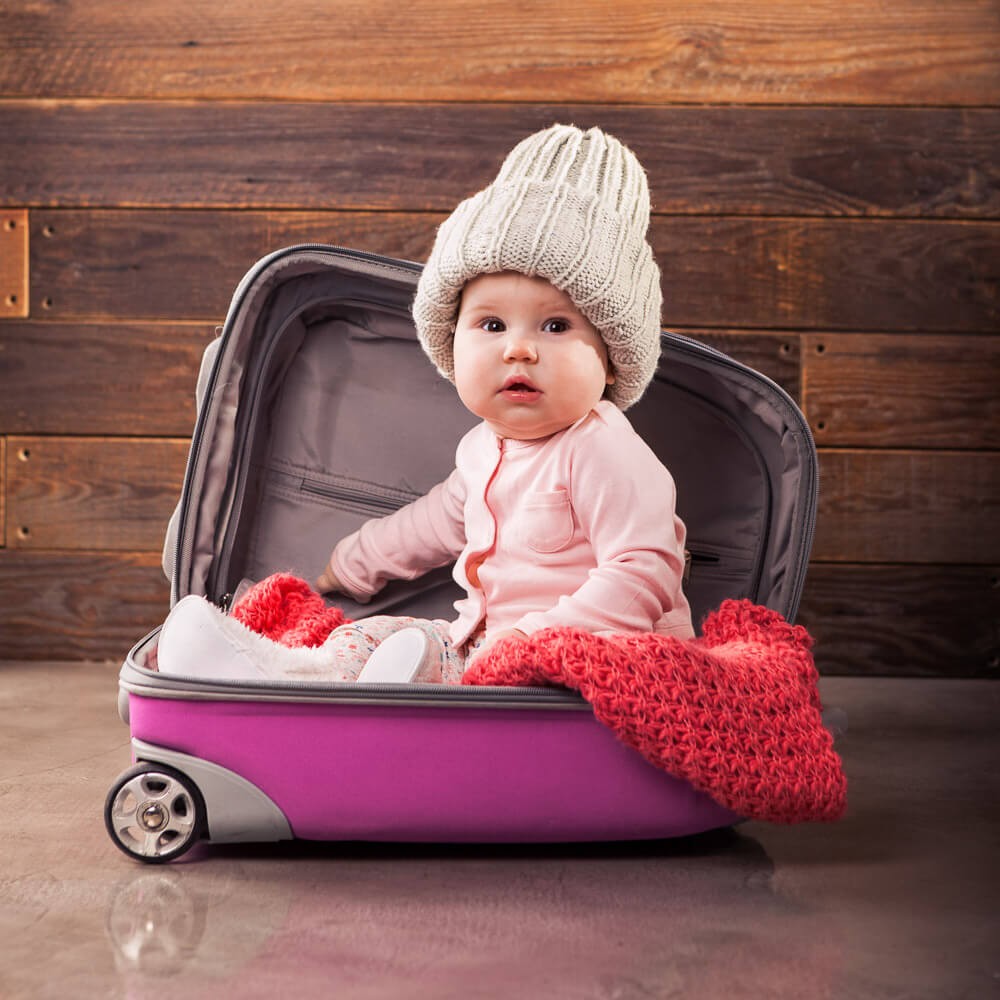 Cute baby in pink travel bag
Cute baby in pink travel bag
Uber and Toddlers: Navigating Rideshares with Young Children
Yes, you can use Uber with a baby or toddler, but there are important considerations. While you can bring and install your own car seat in an Uber, the final decision rests with the driver. It’s advisable to call the driver immediately after booking to inform them about the car seat and your intention to install it. While we haven’t always had time to call ahead, we’ve never been refused a ride when traveling with a car seat.
Remember that a car seat occupies the space of an adult passenger. Avoid booking a standard Uber if you have two adults, a toddler, and a car seat. Opt for Uber XL to ensure ample space for car seat installation and passenger comfort.
Traveling in an Uber without a car seat for your toddler is similar to taxi travel in terms of safety considerations (discussed below), but the legality varies by location, particularly in the US. Always check local regulations and consider calling the driver beforehand if you plan to travel with a toddler without a car seat.
Family-Friendly Rideshare Options with Car Seats
The rideshare market is evolving to better accommodate families. Services offering car seat options are becoming increasingly available. UberCarSeat, for example, allows you to request a ride with a car seat for an additional $10. While availability is currently limited to select cities (specific locations are best checked within the Uber app for your destination), Uber is expanding this service. Lyft is also reportedly working on a similar car seat option.
In Southeast Asia, GrabFamily offers car seat-equipped rides in certain countries. Grab is the dominant rideshare app in the region. However, it’s important to note that these services typically have age and weight restrictions; often, babies must be at least one year old to use the provided car seats. The expansion of these family-focused rideshare options is a welcome development for traveling parents.
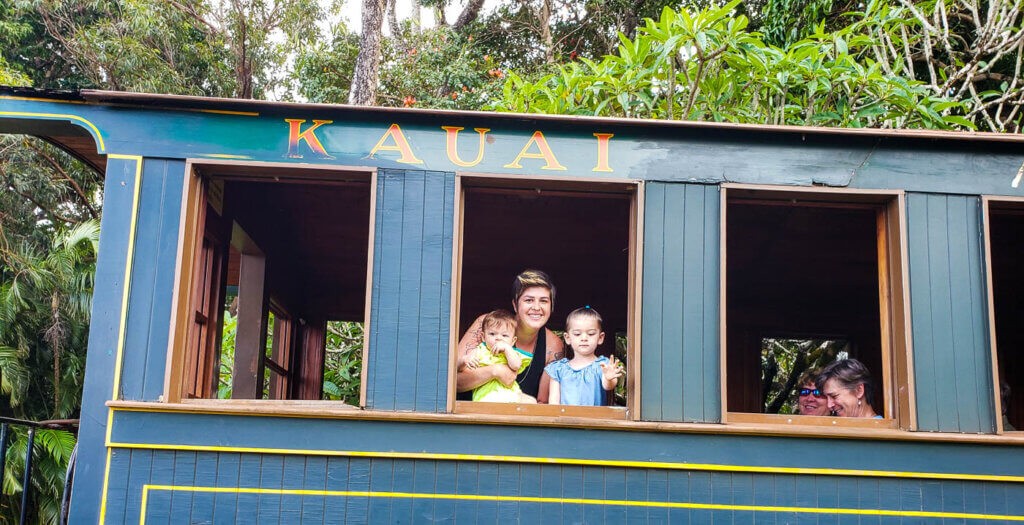 family on train at plantation in kauai
family on train at plantation in kauai
When Taxis are Necessary: Minimizing Risks with Toddlers
Sometimes, taxis are unavoidable. Whether it’s an airport transfer, a short hop across town with a tired toddler, or simply a spontaneous outing without a car seat, taxi travel may become necessary.
Legally, taxi travel without a car seat is permitted in most places, including many US states. However, legal permissibility doesn’t equate to safety.
So, how do you minimize risks when traveling with a toddler in a taxi without a car seat? Realistically, you can’t eliminate all risks. However, you can take steps to mitigate them. Prioritize short trips and avoid highway travel whenever possible. During a trip to Rome with our baby, taxi travel was frequent, but the slow, congested traffic meant speeds rarely exceeded 15 mph, reducing the risk compared to high-speed travel.
In a taxi without a car seat, the safest approach is to have your toddler sit next to you and use the vehicle’s seat belt. Ensure the lap belt is positioned low and tight across the upper thighs, not the stomach. The shoulder belt should rest across their chest, even if it touches their neck, and should not be placed under the arm. Safe Ride 4 Kids and The Car Seat Lady are excellent resources for detailed guidance on this.
While this may not feel ideal, a seat belt is designed to restrain a passenger in a crash, preventing ejection from the vehicle. Holding a toddler on your lap while sharing a seat belt is actually more dangerous. In a collision, your body weight multiplies due to crash forces, potentially crushing the child between you and the seat belt.
In shared taxis or minibuses, like “sheruts” in Tel Aviv, the back row is generally the safest location. Again, using the seat belt for your toddler is the best option.
Some parents might consider babywearing in a taxi, believing it offers some protection. While slightly better than sharing a seat belt, it’s still less safe than using the vehicle seat belt for the toddler. Baby carriers are not designed to withstand crash forces and may not adequately protect your child. Babywearing might be a last resort for very young infants who cannot sit upright, but avoiding taxis without a car seat remains the safest strategy.
If you’ve brought your car seat for air travel, many airport taxis will allow you to install it for the ride to your destination, especially for longer airport transfers. If a driver refuses, don’t hesitate to request another taxi at the taxi stand. In some cities where seat belts are less common in taxis, persistence can often lead you to a taxi with functional seat belts. If taxis prove problematic, consider Uber or local rideshare equivalents, which are more likely to have seat belts (though always check for functionality).
Toddler Travel Without Car Seats: Exploring Alternatives
For toddlers, several portable travel safety products offer alternatives to bulky car seats, particularly for taxi and rideshare use. The RideSafer Travel Vest is designed for children weighing 30-60 lbs and is a favorite for travel. My detailed review of the RideSafer is available here! The Hifold high-back booster is a compact, portable booster seat suitable for children 33 lbs and up. Once children reach age four, various travel booster seat options become available.
We have successfully used the RideSafer vest in numerous taxis and Ubers. Uber is generally preferred due to more consistent seat belt functionality and, in our experience, greater driver patience. While quicker to install than a full car seat, the RideSafer vest still requires a brief installation time that some taxi drivers may be impatient with.
Observing Local Transportation Norms for Toddlers
Around the world, families with children navigate transportation daily. Observing local practices can offer insights and alternative perspectives.
 toddler looking out of ferry at cargo boats in Vancouver Harbor
toddler looking out of ferry at cargo boats in Vancouver Harbor
In Amsterdam, where cycling is prevalent, many families use bikes with integrated baby seats, a safe and practical option in bike-friendly cities. In Southeast Asia, pedicabs and tuk-tuks are common modes of transport. While perhaps not the safest from a collision perspective, requesting drivers to proceed slowly allows for a balance of transportation and enjoying the surroundings.
Accepting the Unforeseen in Toddler Travel Transportation
Despite meticulous planning, travel can be unpredictable. Situations may arise where compromising on ideal safety measures becomes necessary. Parenting, particularly travel parenting, involves managing calculated risks.
During a recent trip to Malta, we encountered this reality. Car seat usage is not widely practiced in Malta. Despite pre-booking and paying for a private airport transfer with a car seat, our return driver arrived without one, citing a 4 am departure and time constraints. With a flight to catch and no alternatives, we had to rely on the driver’s assurance of “driving safely,” a stark contrast to our planned safety level.
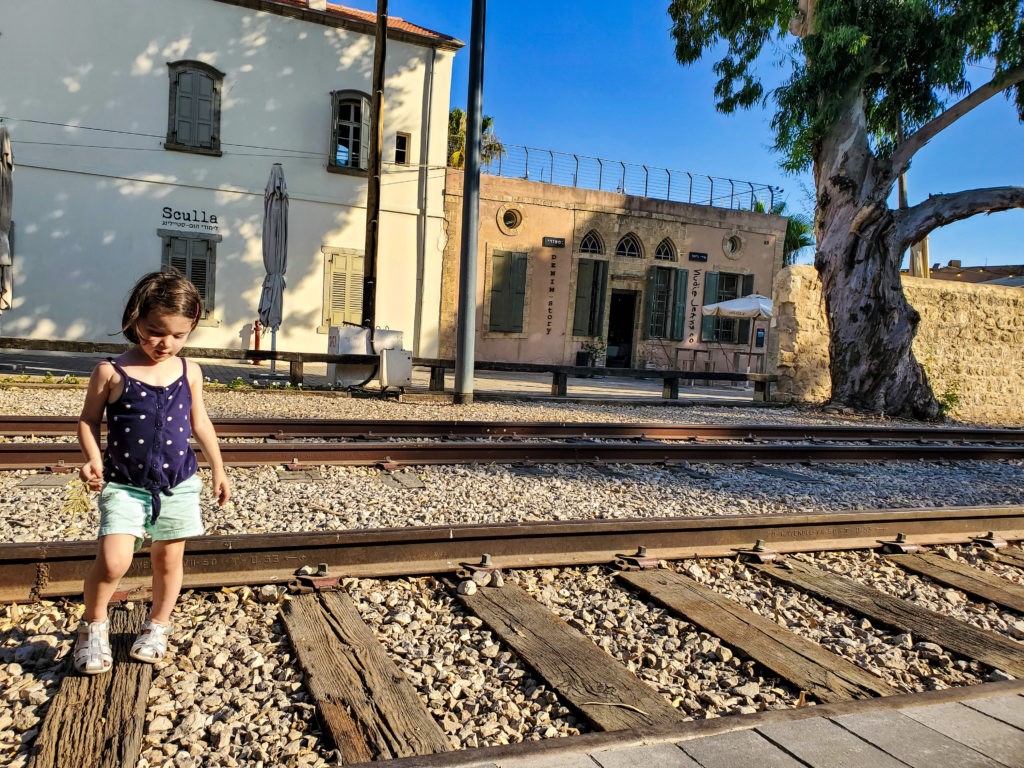 girl standing on railroad tracks in old train station tel aviv
girl standing on railroad tracks in old train station tel aviv
While uncomfortable, this experience highlights the need for flexibility in travel. Sometimes, adapting to local norms and unforeseen circumstances is unavoidable. The goal remains to make informed decisions, prioritize safety where possible, and embrace the journey, creating lasting memories with your family.
What are your go-to strategies for toddler travel transportation without a car seat? Are there any questions I haven’t addressed? Share your experiences and thoughts in the comments below!